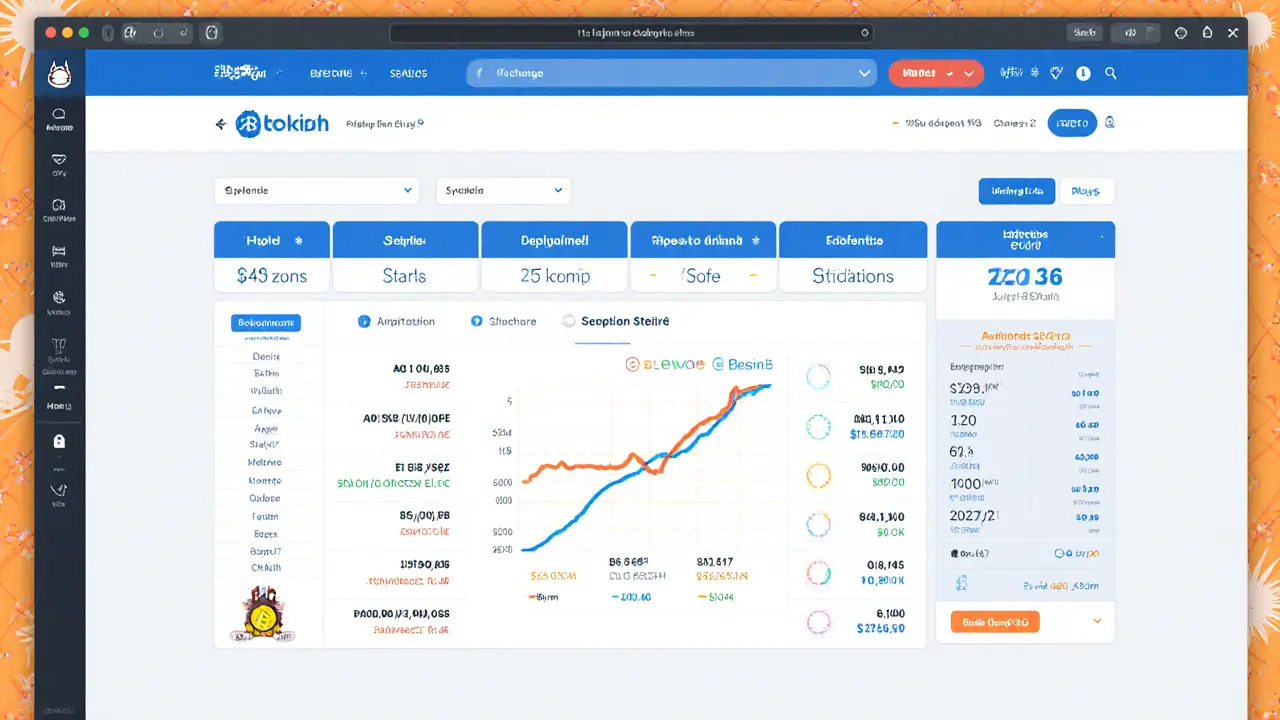Crypto Trade Cost Calculator
Calculate Your Trade Costs
Estimate the cost of your trade including spreads and slippage for different crypto pairs. Based on real market data from the article.
When you glance at any exchange dashboard, the first thing you see are rows like BTC/USDT trading pair - a market where Bitcoin is bought or sold against the stablecoin Tether. Understanding how these pairs work is the key to navigating the crypto market without getting lost in price charts or mysterious fees.
What a Trading Pair Actually Is
In simple terms, a trading pair joins two digital assets so you can swap one for the other. The first asset is the base currency - the one you’re buying or selling. The second is the quote currency - the asset used to price the base. If you see 1 BTC = 26,500 USDT, BTC is the base and USDT is the quote. This notation determines how prices appear on the screen and how orders are matched.
The Core Triad: BTC/USDT, ETH/USDT, and ETH/BTC
Three pairs dominate daily volume across Binance, Coinbase, Kraken and other major venues:
- Bitcoin (BTC) - the original cryptocurrency launched in 2009 paired with Tether (USDT) - the first widely adopted stablecoin pegged 1:1 to the U.S. dollar.
- Ethereum (ETH) - the smart‑contract platform introduced in 2015 paired with USDT.
- ETH paired directly with BTC, letting traders move between two volatile assets without a fiat or stablecoin step.
These pairs differ in liquidity, volatility, and typical use cases, which we’ll break down next.
Liquidity & Volume: Who Moves the Most?
Liquidity is the ease with which you can buy or sell without affecting the price. In Q2 2023, BTC/USDT handled roughly $25 billion of daily volume, making it the most liquid pair. ETH/USDT followed at about $12 billion, while ETH/BTC lagged far behind at roughly $3 billion.
High‑liquidity pairs usually feature tight bid‑ask spreads - often between 0.02 % and 0.05 % on major exchanges. By contrast, a less‑traded pair like ETH/ADA can see spreads over 0.5 %, turning a modest trade into a pricey affair.

Costs You Can’t Ignore: Spreads and Slippage
Every trade pays a spread - the gap between the highest buy order (bid) and the lowest sell order (ask). For BTC/USDT and ETH/USDT the spread is negligible, but when volume drops below $10 million a day, slippage can creep up to 1‑3 % on moderate orders.
Slippage is especially noticeable on cross‑pairs like ETH/BTC. A trader who tried a $10,000 ETH/BTC order on a low‑liquidity exchange reported a 7.3 % loss due to unexpected price movement - a cautionary tale that appears often on Reddit’s r/CryptoCurrency.
Risk Profile: Stablecoins vs. Crypto‑to‑Crypto
Stablecoin pairs (BTC/USDT, ETH/USDT) give price reference in a relatively steady US dollar peg. This reduces volatility: BTC/USDT’s 90‑day standard deviation sits around 0.85, whereas ETH/BTC’s is roughly 1.22. The trade‑off is counterparty risk. If Tether’s reserves were to falter, the entire USDT market - which channels about 48.7 % of all crypto transactions - could wobble.
Crypto‑to‑crypto pairs eliminate the need for a fiat conversion, shaving off two transaction fees and bypassing stablecoin counterparty risk. However, you inherit the volatility of both assets and often face wider spreads.

Choosing the Right Pair for Your Strategy
Here’s a quick decision guide:
- If you’re a beginner, stick to high‑liquidity stablecoin pairs. They offer predictable price behavior and minimal slippage.
- If you want to hedge or arbitrage between Bitcoin and Ethereum without pulling into fiat, ETH/BTC can be useful-but only after you’ve mastered order‑book depth and volatility analysis.
- When the market is turbulent, trade on BTC/USDT for the lowest volatility and most reliable support/resistance levels.
- Always keep an eye on reserve disclosures for stablecoins (MiCA in the EU now forces Tether to publish detailed backing reports).
Future Outlook: Smart Pairs and New Stablecoins
Exchanges are experimenting with “smart pairs” that automatically route orders across multiple venues for best price execution. Kraken’s beta showed an 18.7 % reduction in slippage for BTC/USDT trades. At the same time, USDC is gaining ground - 5.2 % of the stablecoin market share in 2023 - which could diversify quote currencies and lessen the systemic risk tied to a single stablecoin.
Regulators are also tightening oversight. The EU’s MiCA framework demands transparent reserve reporting, which should boost confidence in USDT and other stablecoins. Meanwhile, central bank digital currencies (CBDCs) like the upcoming Digital Euro could introduce fiat‑pegged pairs such as BTC/EURt by 2026, further expanding the ecosystem.

Quick Reference Table
| Metric | BTC/USDT | ETH/USDT | ETH/BTC |
|---|---|---|---|
| Average Daily Volume (2023) | $25 B | $12 B | $3 B |
| Typical Spread | 0.02‑0.05 % | 0.02‑0.06 % | 0.08‑0.12 % |
| 90‑day Volatility (σ) | 0.85 % | 1.00 % | 1.22 % |
| Liquidity Rank (1=most liquid) | 1 | 2 | 5 |
| Primary Use Case | Store of value, entry/exit | DeFi trading, price exposure | Direct crypto‑to‑crypto moves |
Key Takeaways
- High‑liquidity stablecoin pairs like BTC/USDT and ETH/USDT are the safest entry points for most traders.
- Cross‑pairs (ETH/BTC) offer fee savings but bring extra volatility and wider spreads.
- Monitor stablecoin reserve health - counterparty risk can affect up to half the market.
- Future innovations (smart pairs, CBDC‑pegged quotes) will diversify options, but fundamentals of liquidity and spread will stay critical.
What does the “/” symbol mean in a crypto pair?
The slash separates the base currency (left) from the quote currency (right). The price shows how many units of the quote you need for one unit of the base.
Why are USDT pairs so dominant?
USDT’s 1:1 peg to the dollar provides a stable reference point, making it easier to compare values, hedge volatility, and move quickly between assets without converting to fiat.
Is trading ETH/BTC riskier than ETH/USDT?
Yes. You inherit the price swings of both ETH and BTC, and spreads are usually wider. Slippage can also be higher on low‑volume cross‑pairs.
How can I minimize slippage on a trade?
Choose a high‑liquidity pair, use limit orders instead of market orders, and split large orders into smaller chunks spread over time.
What should I watch for when picking a stablecoin as a quote?
Check the issuer’s reserve transparency, regulatory compliance (e.g., MiCA), and market share - a higher‑share stablecoin can pose systemic risk if its backing is questioned.







Jenna Em
October 20, 2025 AT 08:35They keep telling us USDT is just a stable coin, but have you ever thought about who actually holds the backing? Every time the market hiccups I feel there’s a hidden hand pulling the strings. It’s like the peg is a myth fabricated to keep us trading. If the reserves ever disappear, the whole crypto universe could crumble.
Stephen Rees
October 29, 2025 AT 13:48The notion of liquidity sounds comforting, yet it masks a deeper truth: the order books are populated by bots that thrive on our ignorance. When you see a tight spread, it’s often a mirage created by high‑frequency traders. In reality, the price you see is just a consensus illusion, not a guarantee of safety.
Katheline Coleman
November 7, 2025 AT 20:01The elucidation of trading pairs presented herein offers a comprehensive foundation for market participants. By distinguishing the base currency from the quote, traders acquire a clear metric for valuation. The predominance of BTC/USDT and ETH/USDT is unsurprising given their substantial daily volumes. Empirical data from Q2 2023 indicates that BTC/USDT processed approximately twenty‑five billion dollars, thereby establishing it as the most liquid conduit. ETH/USDT follows with a twelve‑billion‑dollar throughput, while ETH/BTC lags considerably with three billion dollars. Liquidity, defined as the capacity to execute sizable orders without materially moving the price, directly influences bid‑ask spreads. For high‑liquidity pairs the spread compresses to a range of two to five basis points, a condition conducive to efficient price discovery. Conversely, less traded pairs such as ETH/ADA may exhibit spreads exceeding fifty basis points, imposing hidden costs upon traders. The phenomenon of slippage emerges when order size eclipses the available depth, a risk amplified on low‑volume pairs. The cited example of a ten‑thousand‑dollar ETH/BTC order suffering a seven‑point‑three percent loss illustrates this hazard vividly. Moreover, stablecoin pairs mitigate volatility by anchoring valuations to the US dollar, yet they introduce counter‑party risk associated with reserve transparency. Recent regulatory developments, notably the EU’s MiCA framework, aim to ameliorate such concerns through mandatory disclosure. Nonetheless, investors must remain vigilant, scrutinising reserve attestations to safeguard against systemic failure. Looking ahead, the emergence of alternative stablecoins such as USDC and the prospect of fiat‑pegged digital assets promise to diversify quote currencies, thereby reducing concentration risk. In sum, a nuanced appreciation of liquidity, spread, and underlying asset dynamics equips market participants to navigate the crypto landscape with informed confidence.
Amy Kember
November 17, 2025 AT 02:15Exactly the reserves are a mystery but the market keeps moving regardless
Evan Holmes
November 26, 2025 AT 08:28Great overview, but I still prefer just holding Bitcoin.
Isabelle Filion
December 5, 2025 AT 14:41Ah, another pedestrian attempt to demystify what seasoned traders have known for years: liquidity is king and stablecoins are merely the court jester. The author’s reliance on bland tables betrays a lack of nuanced insight, as if a spreadsheet could capture the chaotic ballet of order flow. One would hope for a deeper exploration of micro‑structure rather than this superficial recital. Nevertheless, the piece does manage to enumerate the obvious, which is perhaps a service to the uninitiated. In any case, the future of “smart pairs” sounds as revolutionary as attaching a bowtie to a hamster.
Nikhil Chakravarthi Darapu
December 14, 2025 AT 20:55From an Indian perspective, the obsession with USDT reveals a dangerous dependence on foreign‑issued stablecoins. Our regulators are rightly eyeing indigenous digital rupee solutions to curb this exposure. While BTC/USDT dominates globally, home‑grown alternatives could soon reshape the volume distribution. It is imperative that investors consider sovereign digital assets as a strategic hedge against external monetary manipulation.
Lindsey Bird
December 24, 2025 AT 03:08OMG, you just blew my mind! I mean, who knew a “bowtie‑hamster” analogy could be so spot‑on? This article is like a rollercoaster of eye‑rolls and face‑palms – absolutely theatrical! I’m practically screaming from my couch, “Give me more of that sarcastic spice!”